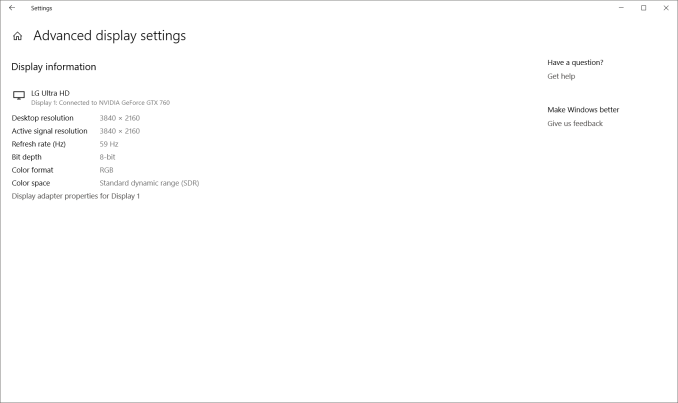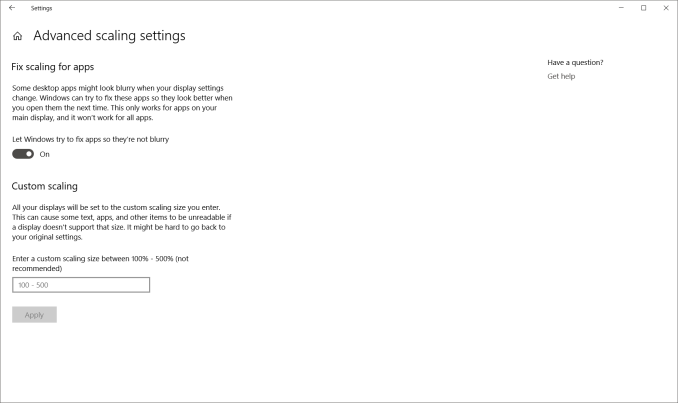The Windows 10 April Update (1803): The Littlest Big Update
by Brett Howse on May 25, 2018 8:00 AM EST- Posted in
- Software
- Operating Systems
- Windows
- Microsoft
- Windows 10
Display Updates: HDR and High DPI
HDR Updates
High Dynamic Range (HDR) is definitely the new buzzword in the display industry, with displays that offer a wider range of brightness levels. There’s more steps between brightness levels, and proper HDR monitors should offer a much higher maximum brightness level as well.
The requirements for HDR haven’t changed very much since the Fall Creators Update, but there’s a couple of small tweaks. If you’re using a laptop, the device manufacturer has to provide a panel that is at least 300 nits or more, but new for the April Update is that the panel is also required to be at least 1920x1080. The laptop will also need to have an integrated GPU that supports PlayReady hardware DRM for protected HDR content, and have the codecs installed for 10-bit video decoding, which is only the latest CPUs. Since you can’t buy a laptop and add HDR, this is all something that has to be handled by the OEM of course.
For external displays, the system and display both need to support HDMI 2.0 or DisplayPort 1.4, as well as HDR10. There’s no support for DolbyVision in Windows yet.
 Your display HDR support is shown here
Your display HDR support is shown here
The GPU must support PlayReady 3.0 hardware DROM for protected HDR content, which is right now a short list of GPUs: AMD Radeon RX 400 or higher, Intel UHD 600 series iGPUs, or NVIDIA GeForce 1000 series cards. All of these cards support the 10-bit video decoding required for HDR.
The PC must have the HEVC or VP9 codec installed as well, and the latest drivers should be used.
HDR is currently only supported for video playback. We’re not yet at a point where the entire OS can be done in HDR.
If you’re using a laptop, Microsoft now has an HDR calibration tool built-in which lets you adjust balance between detail in the dark part of a scene with the brighter parts, and to set if you want HDR to increase display brightness when on battery or not.
High DPI Updates
Using apps created for 96 DPI displays on displays with 200, 300, or more DPI can be a challenge, and over the years, improvements have been made in Windows to better support this. UWP was a possible solution, but with its limited traction it didn’t turn out to be much of a solution, so Microsoft has been fixing both built-in apps to work better on higher resolution displays, as well as fixing issues with using different DPI levels on different displays connected to the system, which is a big issue if you have a new laptop with a high-resolution display, and also dock it with an older 96 DPI monitor.
Microsoft has no real solution to this issue, other than have a dev update their app for HiDPI, but with the April Update Windows 10 will now prompt you to automatically try and fix an app if it think it’s opened with blurry text. You’ll get a notification asking if you’d like to try and fix it, and you can say yes. Then close the app, and hopefully it’s fixed.
Windows was built around 96 DPI as a staple, and with the legacy baggage, this issue will likely never be completely resolved, but luckily most apps work fine now. Some are not perfect, but most of the big name apps now work correctly, which isn’t something you could have said even a couple of years ago.












161 Comments
View All Comments
ChristopherFortineux - Friday, June 8, 2018 - link
Set it as a metered connection stops all upload of any information.sibuna - Friday, May 25, 2018 - link
updated 7 or so comps to it over a week ago. no issues. only thing that happened is on a cpl comps it assigned a drive letter to the hidden system HDD partition which is fixed in about 3 secondsdamianrobertjones - Friday, May 25, 2018 - link
Capitals at the start of sentences can be your friend.deepblue08 - Friday, May 25, 2018 - link
Update was smooth on my Dell XPS 13 (2017) and smooth on my Custom Built 6700K/Z170x/Samsung950Pro machinewr3zzz - Friday, May 25, 2018 - link
I will gladly forgo the new "features" in exchange of no unwanted bugs and getting planned obsolescence forced on me. I cannot believe even with the Pro version I cannot lock down my own OS.ಬುಲ್ವಿಂಕಲ್ ಜೆ ಮೂಸ್ - Friday, May 25, 2018 - link
Same hereI'm still running Windows XP without ANY Microsoft security updates and am on the Internet almost every day with it
It is completely Locked Down and immune to ransomware and other threats
It hasn't had a Blue Screen of Death in over 10 years
and there are no backdoors from Microsoft to worry about
I LOVE IT!
damianrobertjones - Friday, May 25, 2018 - link
I'm looking at Windows 10's group policy via the mmc right now? Why can't you lock it down?wr3zzz - Friday, May 25, 2018 - link
There is no option to opt out of the semiannual updates. The max you can delay an update is 360 days with the Pro. I had to look it up after the FCU broke my Dolby audio and took me more than 30 days to realize it was the OS, by that time it's already past the 30 days rollback period. I reverted the HTPC back to 8.1 to avoid getting the forced obsolescence but what happens when that PC needs to be replaced and the only choice is Win10?Alexvrb - Sunday, May 27, 2018 - link
Don't try to engage with TrollWinkle. He'll tell you how the aliens come probe you if you use Windows 10.PeachNCream - Friday, May 25, 2018 - link
Given the amount of effort Microsoft is putting into making 10 Linux-friendly, I don't see why they wouldn't just fork Debian like everyone else or at least borrow the Linux kernel like Google did with Android.